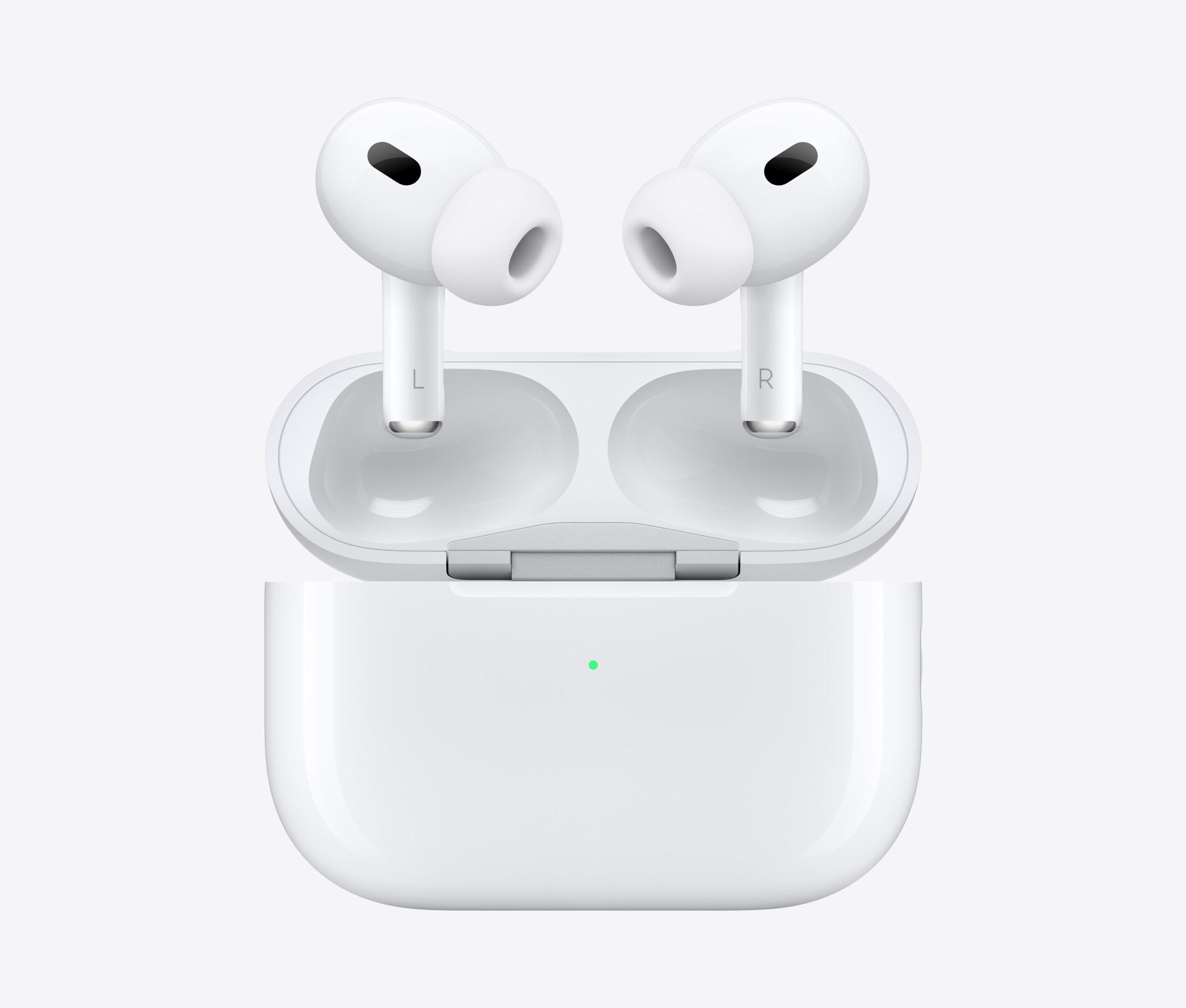Anticipation is building around Apple’s upcoming AirPods Pro 3, with rumors suggesting groundbreaking features that could redefine the wireless earbud experience. Among the most talked-about enhancements are a touchscreen-integrated charging case and advanced health monitoring capabilities.
Touchscreen Charging Case: A New Era of Control
Apple has filed patents indicating the development of a charging case equipped with a touchscreen interface. This innovation would allow users to manage playback, adjust volume, and toggle noise cancellation directly from the case, reducing the need to interact with connected devices. Competitors have already started exploring similar ideas, hinting that Apple is preparing to raise the bar with its own spin on the concept.
Health Monitoring: Heart Rate and Temperature Sensors
Building on Apple’s growing health ecosystem, the AirPods Pro 3 are expected to include heart rate and body temperature sensors. These additions would allow users to track key biometric data while listening to music or working out, and sync that data seamlessly with the Health app. The move aligns with Apple’s broader focus on making its devices more integrated with wellness and fitness tracking.

Enhanced Sound Quality and Noise Cancellation
The introduction of Apple’s next-gen H3 chip is expected to bring significant improvements to sound quality and active noise cancellation. Users can likely expect clearer audio with improved bass, richer mids, and more dynamic range. Noise suppression will also get a boost, offering a more immersive and distraction-free listening experience, especially in crowded or noisy environments.
Live Translation and Infrared Cameras: The Future of AirPods
Looking to the future, Apple is rumored to be working on live translation features, which would allow real-time multilingual communication using AirPods and the Translate app. There’s also speculation about the inclusion of infrared cameras in future models, potentially enabling gesture-based controls or enhanced spatial audio interactions.
Release Timeline and Pricing
While some earlier reports suggested a mid-2025 release, it now seems likely the AirPods Pro 3 will launch alongside the iPhone 17 in September 2025. Pricing is expected to remain close to the current Pro model, around $249, keeping the device firmly positioned in the premium tier of wireless earbuds.
Key Takeaways:
- Innovative Touchscreen Case: Possible built-in display for playback control and settings without needing your phone.
- Advanced Health Features: Heart rate and temperature monitoring to enhance Apple’s health ecosystem.
- Superior Audio Experience: Better sound and noise cancellation thanks to the new H3 chip.
- Forward-Looking Features: Apple is exploring live translation and gesture control with future AirPods.
- Expected Release: Likely debut alongside iPhone 17 in September 2025, with similar pricing to previous models.
Enhancing Call Quality with Firmware Updates
Apple is releasing a firmware update for AirPods that improves call quality by maintaining high audio fidelity even when the microphone is in use. This addresses long-standing issues with poor sound quality during calls, which has affected users across the AirPods lineup, including standard AirPods, AirPods Pro, and AirPods Max. The update enhances audio processing to prevent dropouts and distortions during calls on various platforms like FaceTime, WhatsApp, Teams, and regular phone calls. This represents a notable advancement in Bluetooth audio technology.
Apple has launched an important firmware update for AirPods to improve call quality. This update changes how AirPods manage sound during calls, ensuring high-quality audio even when the microphone is on.
- The new AirPods firmware update maintains high-quality sound during calls when the microphone is active.
- All AirPods models will benefit from this audio enhancement through an automatic firmware update.
- The fix works across multiple calling platforms including FaceTime, WhatsApp, and regular phone calls.
Understanding the AirPods Firmware Update
The new AirPods firmware update addresses a longstanding issue where audio quality would degrade dramatically when users made phone calls. Previously, AirPods would switch from high-quality stereo audio to lower-quality mono audio whenever the microphone was activated during calls.
This problem stemmed from Bluetooth bandwidth limitations. When the microphone turned on, the available bandwidth had to be shared between incoming and outgoing audio signals, forcing the AirPods to reduce audio quality.
The firmware beta introduces a clever workaround to this technical limitation. Instead of accepting the bandwidth constraints, Apple engineers developed a method to maintain stereo inputs even when the microphone is active.
Improvements in Sampling Rate
The key technical innovation in this update involves the audio sampling rate. Before the update, AirPods would drop from a high-quality 48000kHz sampling rate during normal listening to a much lower rate during calls.
With the new firmware, AirPods can now maintain a higher sampling rate during calls by:
- Preserving stereo audio inputs during voice calls
- Optimizing Bluetooth bandwidth allocation
- Using advanced audio processing algorithms
- Balancing microphone input with audio output quality
This improvement is particularly noticeable in voice calls, where previously users complained that audio quality resembled that of “air traffic control” communications – tinny, compressed, and unpleasant.
Impact on User Experience
The improved call quality represents a major enhancement to the AirPods user experience. Many users have reported that calls now sound clearer and more natural, without the dramatic quality drop they previously experienced.
This update benefits:
- Regular voice calls
- FaceTime conversations
- Video conferencing applications
- Voice chat in games and social apps
Early testers have noted that voices sound fuller and more realistic during calls. Background noise is also better managed, making it easier to hear conversations in noisy environments.
The firmware update works across the AirPods lineup, including AirPods Max, though some models may see more dramatic improvements than others. The update appears to be rolling out gradually, with some users receiving it as part of iOS 18’s beta program.
Advanced Features for Clearer Voice Calls
Apple has introduced key improvements to enhance call quality on AirPods, addressing longstanding issues that users have experienced during voice calls and online meetings.
Voice Isolation Feature
The new Voice Isolation feature for AirPods significantly improves call clarity by filtering out unwanted background noise. This smart technology uses computational audio algorithms to identify and prioritize the user’s voice while minimizing ambient sounds that often interrupt important conversations.
To activate Voice Isolation on AirPods with iOS 18, users can:
- Start or join a call
- Swipe down from the top-right corner to open Control Center
- Tap on the “Mic Mode” option
- Select “Voice Isolation” from the available options
Voice Isolation works especially well in noisy environments like coffee shops, busy streets, or windy outdoor settings. The feature uses beamforming microphones on the AirPods to focus on capturing the user’s voice from a specific direction while actively suppressing sounds coming from other directions.
Many users have reported that this feature transforms their AirPods into much more effective tools for professional calls and virtual meetings.
Codec Switching and Bluetooth Profile
Apple’s clever audio trick involves automatic codec switching that maintains high-quality audio even when the microphone is active. Traditionally, AirPods and other Bluetooth headphones would switch to a lower-quality audio codec (SCO) during calls, resulting in that distinctive “air traffic control” sound quality.
The new firmware update changes this behavior by implementing intelligent Bluetooth profile management. Instead of defaulting to the lower-quality Headset profile during all microphone use, the AirPods now maintain the higher-quality A2DP (Advanced Audio Distribution Profile) whenever possible.
This improvement solves long-time issues affecting millions of users by:
- Maintaining audio quality when the microphone is activated
- Preventing the automatic downgrade in sound quality
- Preserving stereo sound during calls instead of mono
- Enabling higher bitrate audio transmission
Users no longer need to choose between clear microphone input and high-quality audio output, as the system now delivers both simultaneously.







